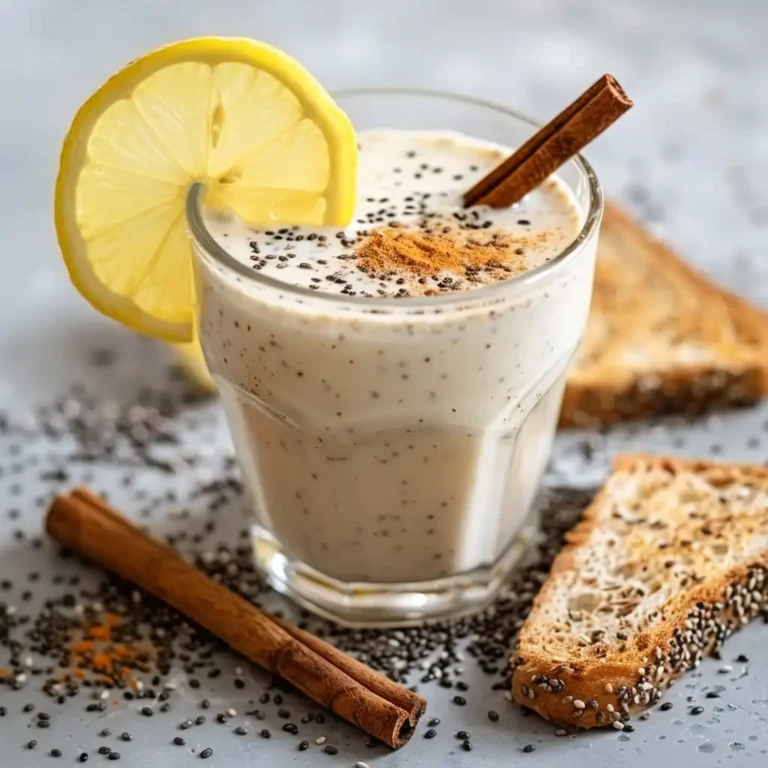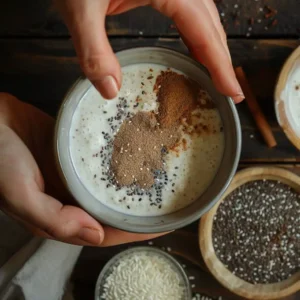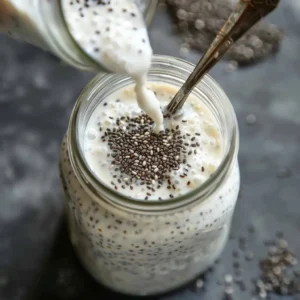When I started searching for a gentle, natural way to feel lighter and more in control of my cravings, I noticed one phrase popping up over and over: Kefir Weight Loss Drink. Every blog and video had something to say. But unlike the flashy claims you’ll find in a typical competitor article—loaded with promises and shortcuts—what you’re about to read here is different. It’s personal, tested in my kitchen, and rooted in real-life curiosity.
I still remember sipping kefir for the first time. It was tangy, slightly fizzy, and surprisingly filling. That small glass kickstarted a journey not just of taste, but of transformation. Over time, I learned how to mix it right, when to drink it, and what ingredients truly made a difference—not just for flavor but for digestion and satiety.
In this article, I’ll walk you through everything I’ve discovered about kefir and its potential as a natural support in your weight loss routine. From what to mix with kefir, when to drink it, how much is “just enough,” and how it stacks up against things like Greek yogurt—I’ll share it all. And if you’re just starting your kefir journey, you’re in the right place.
This guide includes my favorite recipes, tips on making kefir a habit, and a whole section answering the most common kefir questions I’ve been asked (or Googled myself at 11 pm). I’ve also handpicked related drinks that pair beautifully with kefir to support your digestion—like our fermented probiotic lemonade guide and moringa detox water.
Let’s dive in and make your daily drink a moment you look forward to—no crash diets, no gimmicks. Just one glass at a time.
What is Kefir and Why It’s a Game-Changer for Natural Weight Management
Understanding Kefir: Origins, Tradition, and Health Associations
I first heard about kefir while staying with a friend in the Caucasus region, where fermented milk drinks are part of daily life. Their grandmother poured me a cloudy, tart liquid from a ceramic jug and simply said, “Good for the belly.” That was my first kefir experience—long before I knew it would become my go-to drink for feeling light and energized.
Kefir is a fermented milk drink traditionally made using kefir grains, which are clusters of yeast and beneficial bacteria. Unlike yogurt, kefir is drinkable and slightly fizzy, making it feel more refreshing. It’s often made with cow’s, goat’s, or even coconut milk, and it’s been associated with digestive support, appetite control, and even better skin, thanks to its probiotic content.
The Fermentation Factor: How Live Cultures in Kefir May Support Gut Health
What makes kefir truly stand out in the world of wellness drinks is its powerful blend of live active cultures. We’re talking about over 30 strains of good bacteria and yeasts that work together to support the digestive system. From my experience, this probiotic powerhouse has helped reduce that heavy, bloated feeling I used to get after meals.
Fermented drinks like kefir are thought to support the balance of gut microbiota, which may play a role in how our bodies digest food and store fat. Many people, myself included, notice a difference in regularity, energy levels, and even appetite after introducing kefir into their daily routine.
And unlike some trendy drinks that come and go, kefir has roots going back centuries. It’s still a daily staple in places like Russia, Turkey, and parts of Eastern Europe—not just for taste, but for how it makes you feel.
Difference Between Kefir and Other Fermented Drinks (Like Buttermilk or Yogurt)
Let’s clear this up: kefir is not just another yogurt in disguise.
| Comparison | Kefir | Yogurt | Buttermilk |
|---|---|---|---|
| Probiotic Count | 30+ strains | 4–6 strains | 2–3 strains |
| Texture | Thin and drinkable | Thick and spoonable | Thin and mild |
| Taste | Tangy and slightly fizzy | Mildly tangy | Mild and sour |
| Fermentation | Mixed bacteria + yeast | Bacterial cultures only | Often cultured post-pasteurization |
| Lactose Content | Lower (easier to digest) | Moderate | Moderate |
From my experience, kefir is much easier on the stomach—especially if you’re sensitive to dairy. The fermentation process breaks down much of the lactose, making it more lactose-friendly than other milk-based drinks.
Want something similar but with a fruity twist? Don’t miss our kefir soda recipe—a bubbly version that’s great for summer sipping.
So, whether you’re trying kefir for digestion, weight balance, or just curious about fermented drinks, know this: it’s not just a trend. It’s a tradition that stands the test of time—and your gut might just thank you.
How Kefir Weight Loss Drink May Help with Weight Loss Naturally
The Role of Probiotics in Metabolism and Digestion
When I first began including kefir in my meals, I wasn’t chasing a miracle solution. I just wanted something that felt lighter than my usual breakfast—and that’s when I started noticing small but powerful shifts. My digestion felt smoother, my cravings dropped off, and I felt comfortably full for longer. Over time, I realized: this wasn’t just a gut feeling—something was working.
Kefir is rich in probiotics, those live microorganisms known for supporting gut flora. And a balanced gut may contribute to better nutrient absorption, reduced bloating, and more efficient digestion. While research is still ongoing, many nutrition experts believe that gut bacteria can influence metabolism and even the way your body stores fat.
A healthy gut environment may also reduce inflammation, which is often associated with weight gain or difficulty losing weight. So rather than focusing only on calories, kefir supports your body from the inside out.
Kefir’s Potential to Reduce Cravings and Improve Satiety
Let me be honest—I love snacks. But ever since I started drinking kefir in the morning, those mid-morning hunger pangs have chilled out. That’s likely because kefir is packed with protein and has a naturally occurring fat content (especially if you use whole milk kefir), both of which help with satiety—the feeling of being full and satisfied.
What sets it apart from other “filling” foods is how light it feels going down. It’s not heavy like a smoothie or thick like Greek yogurt, yet it somehow keeps me from reaching for cookies by 11 a.m.
There are days when I mix kefir with cinnamon and a few chia seeds, and that combo keeps me going until lunch. The natural sourness also curbs my sweet tooth. It’s a win-win.
If you’re someone who tends to snack late at night, you might find that having a glass of kefir post-dinner helps you feel grounded and content.
Want something that balances flavor and fullness? Check out our chia seed water recipe—another hydration hack I’ve leaned on during busy weeks.
Personal Story: How I Felt Lighter in Just a Week of Drinking Kefir
After just one week of drinking kefir daily (I started with half a cup in the morning), I noticed two things: I wasn’t bloated by lunchtime, and I didn’t feel the need to graze between meals. My energy stayed more stable, and I felt more “in tune” with my hunger cues.
By week two, I was sleeping better and even dropped a couple of pounds—not because I was eating less, but because I wasn’t mindlessly snacking anymore.
Of course, every body is different. But if you’re looking for something to ease digestion and support your natural rhythm, kefir could be your glass-a-day go-to.
Looking for more gut-friendly drinks? You’ll love our moringa detox water for weight loss—it pairs beautifully with kefir during a light, hydrating day.
What to Add to Kefir for Weight Loss Support
Fat-Burning Mix-ins: Lemon, Chia Seeds, Ginger, Cinnamon
The beauty of kefir is how adaptable it is. You can drink it plain, of course, but I’ve found that mixing in the right ingredients not only upgrades the flavor—it enhances the feeling of satiety and refreshment too. Here are a few of my favorite natural add-ins that may support weight management:
- Lemon Juice: A splash of fresh lemon not only brightens the taste but may aid digestion. It adds a dose of vitamin C and helps balance the tartness of kefir.
- Chia Seeds: These tiny seeds absorb liquid and swell, helping you feel fuller longer. They also bring in omega-3s and fiber, which may help regulate hunger.
- Fresh Ginger: Just a touch of grated ginger adds warmth and depth while being traditionally used to support metabolism and gut health.
- Cinnamon: A half-teaspoon adds subtle sweetness and is known for its potential to help regulate blood sugar levels.
I usually combine all four for what I call my “Morning Belly Reset.” It tastes like a spiced lassi with a probiotic twist—and I look forward to it every morning.
My Favorite Kefir Recipe That Helps Me Stay Full and Energized
Here’s a go-to blend I whip up on busy mornings when I want something light, creamy, and filling without making a full meal.
Sifaw’s Morning Kefir Belly Reset
- 1 cup unsweetened plain kefir
- Juice of ½ lemon
- 1 teaspoon chia seeds
- ¼ teaspoon grated ginger
- ½ teaspoon cinnamon
- Optional: drizzle of raw honey if you’re new to kefir and need to adjust to the tang
Shake it all together in a mason jar and let it sit for about 10 minutes (so the chia expands). Drink slowly and feel how grounded and nourished you become.
It’s also a great companion to our internal shower chia seed water—a hydration technique I use on extra busy or post-travel days.
Caution: Ingredients You Might Want to Avoid in Kefir Blends
Not every add-in is weight loss friendly. If you’re blending kefir at home, try to skip these common pitfalls:
- Flavored Syrups: These often have hidden sugars that can spike your blood sugar and leave you hungrier later.
- Bananas: While healthy, they’re calorie-dense and can quickly turn your light drink into a heavy snack if not balanced.
- Fruit Juices: These add sweetness but no fiber, and the extra sugars can cancel out the benefits.
Stick to whole, fiber-rich, or spice-based ingredients. From my experience, keeping it light but flavorful makes it easier to stay consistent without feeling like you’re on a “diet.”
Print
Kefir Weight Loss Drink: Why Quality Ingredients and Texture Matter Most
A naturally tangy and refreshing probiotic drink that supports digestion, curbs cravings, and helps you feel light and energized.
Ingredients
- 1 cup unsweetened plain kefir
- Juice of 1/2 lemon
- 1 teaspoon chia seeds
- 1/4 teaspoon grated fresh ginger
- 1/2 teaspoon ground cinnamon
- Optional: drizzle of raw honey (for taste adjustment)
Instructions
- Shake all ingredients together in a mason jar until well combined.
Fresh lemon juice is added to kefir, boosting vitamin C and digestive support - Let sit for 10 minutes to allow chia seeds to expand.
- Sip slowly, preferably in the morning on an empty stomach.
A spoon stirring grated ginger and chia seeds into kefir for a spiced gut-friendly blend - Store leftovers in the fridge and shake before drinking.
The first step of the Morning Belly Reset: pouring kefir into a jar before adding fat-burning ingredients
Notes
For best results, start with ¼ cup per day and gradually increase to 1 cup. Avoid flavored syrups or high-sugar fruit juices as mix-ins.
When and How to Drink Kefir for Weight Loss
Morning vs. Night: What Works Best Based on My Routine
When I first started drinking kefir, I wasn’t sure if it was better in the morning or before bed. So I tried both. What I found was this: drinking kefir in the morning on an empty stomach helped me feel lighter and more focused throughout the day. I wasn’t as snacky, and my digestion felt smoother by noon.
In contrast, on days when I had kefir at night, it helped calm my stomach after a heavy dinner—but I didn’t sleep as deeply. That slight buzz from the fermentation and tangy taste gave me more of a “wake up” feeling than a wind-down.
Now, I stick with a morning glass of kefir—usually 20 minutes before breakfast. It’s my way of gently waking up my system, kind of like a probiotic alarm clock.
Of course, everyone’s rhythm is different. Some of my friends swear by a post-dinner kefir drink to keep digestion on track overnight. Try both and see what fits your lifestyle.
Ideal Serving Size and Frequency for Digestive Comfort
When it comes to how much kefir to drink daily, I’ve found that ¾ to 1 cup per day is the sweet spot. Any more than that, especially in the beginning, can cause gas or bloating. This is totally normal—your gut is adjusting to the influx of good bacteria.
If you’re new to kefir, start slow:
| Day | Amount |
|---|---|
| Day 1-3 | ¼ cup in the morning |
| Day 4-6 | ½ cup before breakfast |
| Day 7+ | ¾ to 1 cup daily |
Over time, your digestive system should adapt, and you’ll feel more comfortable increasing your intake.
I pair mine with light meals or healthy snacks, like those in our low-calorie high-protein snack guide, to keep energy levels stable.
Should You Drink Kefir on an Empty Stomach?
Personally? Yes. That’s when I feel the biggest difference.
Having kefir first thing in the morning, before coffee or breakfast, gives the probiotics a better chance of reaching the gut without interference. Some studies and nutritionists suggest that probiotics may survive stomach acid better on an empty stomach—though findings vary.
What I can say from experience is this: when I start my day with kefir alone, my stomach feels calm and less bloated by midday. It sets the tone for how I eat and move throughout the rest of the day.
Still, if it feels too strong first thing, try pairing it with a light slice of whole grain toast or a boiled egg. That little buffer might help as your gut gets used to its new routine.
Kefir vs Greek Yogurt: Which is Better for Weight Loss?
Nutritional Comparison: Protein, Sugar, and Probiotic Content
I’ve had both Greek yogurt and kefir in my fridge for years, often swapping one for the other depending on the season. But when it comes to weight loss support, I started paying closer attention to what each offers. Here’s what I found:
| Nutrient (per 1 cup) | Kefir (plain) | Greek Yogurt (plain, nonfat) |
|---|---|---|
| Calories | ~100 | ~130 |
| Protein | ~9g | ~20g |
| Sugar (natural) | ~10g | ~6g |
| Fat (whole version) | ~3-5g | ~0-10g (varies) |
| Probiotics | 30+ strains | 4-6 strains |
| Texture | Drinkable | Spoonable |
Kefir is lower in calories and easier to drink, especially on the go. While Greek yogurt packs more protein, kefir contains a more diverse range of probiotics, which may be more beneficial for digestion and gut balance—two factors that can indirectly support weight loss by improving how your body processes food.
Digestion and Bloating: Which One Feels Lighter?
Here’s where kefir truly won me over.
Greek yogurt always left me a bit heavy. Even when I stuck to smaller portions, I’d feel weighed down after breakfast. On the other hand, kefir has a much lighter texture and seems to settle faster in my stomach. Its fermentation process breaks down more lactose than yogurt, which is helpful if you’re sensitive to dairy like me.
Kefir also seems to “cool” my digestion—it never sits like a rock. After a week of drinking it in the mornings, I noticed less bloating, fewer stomach rumbles, and steadier hunger levels.
From my own experience and many chats with fellow kefir fans, this drink seems to be easier to tolerate daily—especially for those trying to reduce inflammation or discomfort after meals.
My Experience: Swapping Greek Yogurt for Kefir
For years, Greek yogurt was my go-to for breakfast and post-workout snacks. But once I started incorporating kefir, I realized I preferred how it made me feel. I still enjoy yogurt from time to time, especially in bowls with fruit, but now I use kefir more consistently because:
- It’s faster—I can sip it on my way out the door.
- It helps keep cravings in check.
- It plays nicer with my stomach.
And when I really want to kick things up, I blend kefir with turmeric and black pepper—two ingredients I picked up while reading about natural anti-inflammatory remedies during a trip to Morocco.
So is kefir better than Greek yogurt for weight loss? In my kitchen, yes—but it all depends on your needs. If you want something probiotic-rich, light, and easy to drink, kefir might just win a spot in your fridge.
Best Kefir Recipes for Weight Loss at Home
DIY Kefir Smoothie Recipes with Fat-Burning Ingredients
One of my favorite things about kefir is how well it blends into smoothies. Whether I’m rushing out the door or winding down after a long day, I’ve crafted recipes that not only taste great but support digestion and satiety.

Here are two I rotate through the week:
1. Green Kefir Energizer
- 1 cup plain kefir
- ½ green apple (peeled)
- Handful of spinach
- Juice of ½ lemon
- 1 tsp chia seeds
- Ice cubes
This smoothie is light, tart, and perfect for mornings when I want to feel refreshed without getting weighed down. The spinach adds a nice green flavor without being overpowering.
2. Spiced Belly-Soothing Blend
- ¾ cup kefir
- ¼ avocado
- ½ tsp ground cinnamon
- ¼ tsp ginger powder
- ½ tsp flaxseed
- Splash of almond milk (if needed)
This one’s creamy, rich, and a lifesaver when I’m feeling bloated or sluggish. The healthy fats in avocado help me stay full longer, and the spices warm the belly from the inside out.
Looking for a unique summer detox idea? You’ll love our berry basil detox drink, which pairs beautifully with kefir smoothies on alternating days.
Meal Replacement or Snack? How I Use Kefir in My Daily Plan
Some days, kefir is my breakfast base—other times, it’s a late afternoon snack when I’m craving something creamy. I’ve found that using it as a meal supplement rather than a full meal helps with consistency. Here’s how it fits into my typical weekday:
| Time | Use |
|---|---|
| 7:30 AM | 1 cup kefir + chia + lemon (empty stomach) |
| 10:00 AM | Light protein snack |
| 3:30 PM | Kefir smoothie with avocado or banana |
| 6:00 PM | Balanced dinner |
| Optional | ½ cup kefir post-dinner if I feel bloated |
The flexibility of kefir makes it easy to include without disrupting your current eating pattern. It’s not about restriction—it’s about small, meaningful additions.
Kefir-Based Detox Drink for Light Dinner Nights
When I’ve had a heavy lunch or just want to go light at night, I make this kefir-based detox drink. It’s cooling, hydrating, and perfect for unwinding after a long day.
Kefir Cucumber Cleanser
- ¾ cup kefir
- ¼ cucumber, peeled and grated
- 1 pinch sea salt
- 3 mint leaves (chopped)
- Dash of black pepper
Stir everything together and let it sit for 5 minutes to allow the flavors to meld. It’s inspired by the Indian “chaas” and feels like a hug to my digestive system.
This one also reminds me of our refreshing cucumber-ACV cooler—another hydrating favorite worth bookmarking.
How Much Kefir Should I Drink Daily for Weight Loss?
What’s a Safe and Effective Daily Dose Based on Experience
When I first started drinking kefir, I made the mistake of diving in too fast. One full glass, right away—and let’s just say my stomach let me know it wasn’t ready.
From that lesson, I began easing into it. And now, after months of including kefir in my diet, I’ve found that ¾ to 1 cup daily works best for weight support, digestion, and satiety—without discomfort.
Here’s a basic weekly progression I recommend if you’re starting fresh:
| Days | Amount | Notes |
|---|---|---|
| Day 1–3 | ¼ cup | Sipped slowly in the morning |
| Day 4–6 | ½ cup | Add lemon or ginger to ease digestion |
| Day 7+ | ¾ to 1 cup | Your gut should be adjusting by now |
The goal is not to flood your system, but to gently build a healthy habit that your body welcomes daily.
Building a Tolerance: Start Small, Go Slow
Because kefir is a live, fermented drink, it can cause some initial reactions—especially if your gut isn’t used to a lot of probiotics.
Some signs that you’re drinking too much too fast:
- Frequent gas or bubbling in the stomach
- Bloating after meals
- Loose stools
If this happens, don’t quit—just reduce the amount. In my case, going from 1 cup down to ½ for a few days made all the difference. Now, kefir feels like a calming addition, not a shock to the system.
Think of it like introducing a new friend to your body—slow introductions lead to strong, lasting friendships.
Listening to Your Gut: What Signs to Watch For
You don’t need fancy trackers or biofeedback tools—just pay attention to your energy, digestion, and cravings.
Here are a few positive signs that kefir is working for you:
- You feel comfortably full after drinking it
- You notice less bloating after meals
- You’re snacking less throughout the day
- Your bathroom routine feels more regular
And of course, if you feel discomfort, listen to that too. Not everyone will tolerate kefir in the same way. For those sensitive to dairy or very new to fermented foods, spacing it out every other day might work better.
When paired with other natural supports—like our lemon balm tea recipe—kefir becomes part of a gentle wellness routine that you can truly stick to.
Real Tips from My Kitchen: Making Kefir a Daily Habit
How to Make Kefir Taste Better Without Adding Sugar
Let’s be honest—plain kefir can be… an acquired taste. When I first tried it, I scrunched up my face and thought, “There’s no way I can do this every day.” But instead of quitting, I got creative.
Here are some ways I naturally improved the flavor without relying on sugar or artificial flavors:
- Add cinnamon and nutmeg – warm spices mask the tangy notes and make it feel cozy.
- Squeeze in citrus – lemon or orange juice balances out the sour bite.
- Blend with berries – a few frozen blueberries or strawberries give it a smoother finish.
- Use unsweetened cocoa – a teaspoon of raw cacao powder creates a rich, dessert-like twist.
These little upgrades turned kefir from a chore into a treat. If you’re someone who struggles with taste but wants the benefits, try one or two of these combos until you find your perfect blend.
Creative Ways to Mix Kefir Into Breakfast, Snacks, and Dinners
Kefir isn’t just a drink—it’s an ingredient. Once I embraced that, my kitchen felt more playful. Here’s how I started weaving it into my daily rhythm:
- In place of milk: I use kefir in overnight oats for extra creaminess and probiotics.
- As a salad dressing base: Mixed with olive oil, lemon juice, and herbs, it makes a zesty drizzle.
- As a dip: I blend kefir with mashed avocado, garlic, and lemon for a tangy spread.
- In smoothies: A given—but try pairing it with turmeric or matcha for a fat-burning kick.
If you’re feeling bold, try pairing kefir with savory recipes like our bariatric seed drink—the combo works surprisingly well when you’re craving depth and texture.
My Weekly Kefir Prep Routine (with Table)
To make kefir a daily, no-excuse habit, I prep every Sunday night. Here’s a snapshot of my weekly rhythm:
| Day | Kefir Plan | Add-Ins |
|---|---|---|
| Monday | Plain kefir (AM) | Lemon juice + chia |
| Tuesday | Smoothie (PM) | Avocado + cinnamon |
| Wednesday | Salad dressing | Olive oil + dill |
| Thursday | Dip with veggies | Avocado + garlic |
| Friday | Kefir soda treat | Mint + cucumber |
This small act of prepping add-ins and bottles in advance helped me stay consistent without effort. When it’s already in the fridge, ready to go, you’re way more likely to keep the habit alive.
FAQs About Kefir for Weight Loss (Answered with Experience)
What to add to kefir for weight loss?
From my own kitchen experiments, the best things to add to kefir for weight support are ingredients that help with digestion and satiety—without spiking blood sugar. My go-to blend includes lemon juice, chia seeds, ground cinnamon, and a touch of fresh ginger. These mix-ins not only enhance flavor but may also help you stay full longer and reduce cravings. Sometimes I’ll add flaxseed or a spoonful of raw cacao powder when I want something more satisfying.
Avoid sugary fruits or flavored syrups—they defeat the purpose.
How much kefir should I drink daily for weight loss?
I’ve found that ¾ to 1 cup per day is the sweet spot. Any more, and your gut might need time to adjust. Start with ¼ cup if you’re new to it, then build up over a week. Drink it first thing in the morning for best results. I usually stick with once a day, but on days I feel sluggish or bloated, I’ll sip a second half-cup in the evening.
Always listen to your body—too much too soon can lead to bloating or discomfort.
When to drink kefir, morning or night for weight loss?
Personally, morning wins every time. Drinking kefir on an empty stomach gives me a fresh start, supports digestion throughout the day, and helps control my cravings. That said, some people find it soothing at night, especially after a heavy meal. If you’re unsure, try both and see what feels best.
My tip: Start your day with a simple kefir-lemon-chia blend, and see how it affects your energy and appetite.
Is kefir better than Greek yogurt for weight loss?
For me, yes—and here’s why: Kefir is lighter, easier to digest, and packs more probiotic strains than Greek yogurt. While yogurt has more protein, kefir wins with versatility, texture, and how quickly I noticed improvements in bloating and hunger control. Plus, it’s easier to drink on the go and blends beautifully into both sweet and savory recipes.
That said, both can be part of a balanced plan—just depends on your digestion and lifestyle. Kefir simply fits mine better.
Conclusion
Adding kefir to my routine started as a gut-health experiment—but it turned into a daily ritual that genuinely helped me feel more in control of my hunger, digestion, and energy. Whether I sip it straight, blend it into smoothies, or sneak it into a salad dressing, kefir now has a permanent spot in my fridge.
If you’re new to it, take it slow. Start with small sips, try different add-ins, and listen to your body. You don’t need to overhaul your diet—just one cup a day can be a gentle, nourishing shift toward better balance.
Looking for more ideas to pair with your probiotic routine? Don’t miss our fermented probiotic lemonade guide for a tangy twist that complements kefir beautifully.
Follow my real-time recipes and behind-the-scenes tips on Facebook and Pinterest. I share new blends, seasonal flavors, and how I keep things simple and sustainable in my kitchen.
This recipe is shared for informational purposes and is not a substitute for medical advice. Results may vary from person to person. Always consult with a healthcare provider before starting any new dietary routine.










